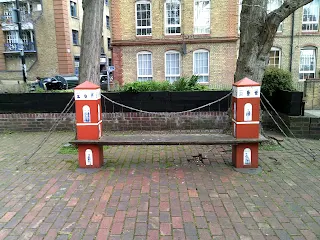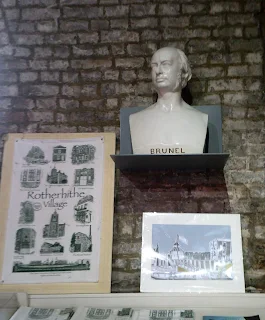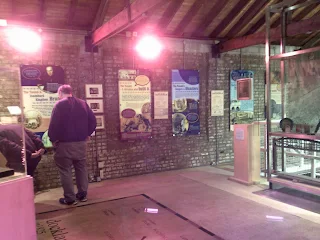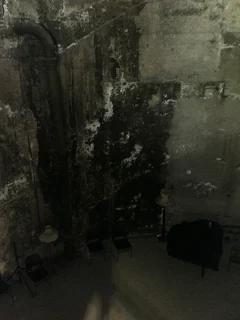The Thames Tunnel travels beneath the water and connects Rotherhithe and Wapping, in London. The brainchild of Marc Isambard Brunel (1769-1849), using tunnelling shield technology patented by himself and the controversial Admiral Thomas Cochrane (1775-1860), the project was carried out by Brunel and his son, Isambard Kingdom Brunel (1806-1859). It was the only project these famous and innovative engineers worked on together.
French-born Marc is considered by many to have been a better engineer than his son, but it was Isambard Kingdom who was more prolific. As well as the Thames Tunnel, the latter was responsible for: the Great Western railway- from Paddington station to the West Country; the Hungerford Suspension Bridge over the Thames- whose pillars are still there, although the chains now form part of his Clifton Suspension Bridge over the Avon gorge; the water towers for the Crystal Palace (built to house the Great Exhibition, in Hyde Park in 1851) fountains and the Great Eastern steamship.
Isambard's lesser famous son, Henry Marc Brunel (1842-1903) was also a structural engineer, partially responsible for the Blackfriars Railway Bridge. He was the first person to travel through the tunnel, handed along as a baby by his proud father.
The Thames Tunnel is 35 feet (11 metres) wide, 20 feet (6 metres) high and 1,300 feet (396 metres) long. It runs 75 feet (23 metres) below the surface of the river (when measured at high tide). The project began in 1825 and was supposed to take three years to complete. Instead, it took 18 years, and was finally finished in 1843! Originally intended for horse-drawn carriages and pedestrians, it's ironic that by the time of its completion the Industrial Revolution had taken place and the tunnel got its railway in 1869. It is now the oldest tunnel in the world's oldest railway system, and today the tunnel is still in use, as part of the London Overground.
The museum is the only monument to both Marc Isambard and Isambard Kingdom Brunel.
We took the Overground, to Rotherhithe. It's the first time I have ever used this station, and we could see down the actual Brunel tunnel from the platform.
The short walk from the station...
Past the Christmas tree😊 and round to the museum...
Plaque dedicated to Isambard Kingdom Brunel...
It was a chilly yet sunny day, so we stopped to gaze over the Thames from the south bank, over to the City and the Shard...
...And directly ahead, to Wapping Old Stairs (one of a number of watermen's stairs) leading down into the river. The Town of Ramsgate (a historical dockers' pub) is behind the modern buildings...
Over to the right and you can just about make out the white building which is another historical pub; The Prospect of Whitby. I spent part of my 35th birthday in the beer garden there, and ended up getting sunstroke (but that's another story...)
I visited both of the aforementioned pubs on that day, after reading this fantastic book which was set in the docklands; about a young woman's struggle to survive in Jack the Ripper's London followed by her fleeing in terror to New York, her self-made success and eventual return to England...
The Tea Rose is by Jennifer Donnelly and it sat in my bookcase for years, until it fell to bits. It's one of my all-time favourite reads and I've reviewed it here...
The lump sticking out of the Thames, to the right of the photo, is apparently part of a man-made jetty.
Thames beach- I'm not too sure I wanted to pop down and sunbathe here!
Now moving on to the museum and the garden has these benches, inspired by Isambard Kingdom Brunel's famous work. This is the original Hungerford Suspension Bridge. The towers still survive and trains still pass overhead on a more modern structure, but the chains now from part of Clifton Suspension Bridge.
The Royal Albert Bridge, which runs from Plymouth, Devon, to Saltash, Cornwall and crosses the river Tamar.
Museum chimney...
Plaque explaining Brunel's pump and engine house. The Engine House is where the museum is situated. The shaft down to the tunnel was dug right here...
Bust of Marc Brunel (out of father and son, I think he's the better looking😉)...
Bust of Isambard Kingdom Brunel...
View of this upstairs gallery...
The floor explaining London's docklands...
Cabinet of souvenir items from the project...
These viewfinders show life carrying on above and below the water...
Below the Thames- it was hard maintaining a steady hand to photograph this!
Above the Thames...
The second viewfinder showed how the entrance hall was supposed to look...
The famous tunneling shield, which enabled the project to take place. It was a rectangular frame with 36 cells, each holding a man with a pick and shovel. As the men dug, the shield was moved forward, the bricklayers shored the tunnel up behind and the debris was taken back to the surface, to be fired into bricks.
Side view of the tunnel and a Vain Old Tart...
Downstairs. This is actually by the toilets but I just liked the Brunel Road sign!
A film about their achievements is constantly showing on a loop...
Tunnel explanation...
Tunnel picture...
I assume this chain is inspired by the launching chains for the SS Great Eastern, an iron sailing steamship.
We got to have a talk by a guide, down in the tunneling shaft, also known as the Grand Entrance Hall. Here are the stairs down...
This was the wackiest place ever, with a bar (unfortunately not open...)
...A grand piano at one side...
...And lampshades dotted around...
It's very industrial looking down here, as you would expect. The pace of work to dig the tunnel was slow, and the project was always running out of money, and additional funding had to be found. Fortunately, Isambard Brunel was a good spin doctor when it came to courting influential people.
The ceiling. It was very dangerous- albeit well paid- working down here, and Isambard Brunel gained the respect of his fellow workers by often putting in a 36 hour shift.
Dank walls. It was very cold down here! Isambard Brunel took over the role as Chief Engineer at only 20 years old, after his predecessor had his health destroyed by overwork. Marc Brunel himself had a stroke.
During construction, the tunnel was always leaking. Isambard nearly died when the Thames burst in through the roof, in January 1828. Trapped under a falling beam, he tore himself free and was pulled up through this grating shaft high up on the wall.
Gazing down at the piano in the shaft. When the tunnel eventually opened, it was a success, with one million people (half the population of London) paying a penny each to cross underneath the Thames in the first 15 weeks of its opening.
Looking down from the top. The challenges provided by the tunnel convinced Isambard Brunel that nothing was impossible, and his career went from strength to strength.
My arty photo of the shaft stairs...
Outside and gazing up at the museum sign...
I loved these fish decorations...
This seat and table is inspired by a ship. The garden contains shrubs and trees such as those chosen by Brunel for his garden in Watcombe, Devon, and raised beds planted with fruits and herbs...
This 'sculpture' is a priming pump, from Surrey Docks.
The SuperDean looking at the shaft head. That sounds incredibly mucky, doesn't it? Oh well, this is MY blog- what else do you expect?!😉😄
Looking back at the tower (which was rather in silhouette) from the road...
Tunnel Road...
The Mayflower pub...
We finished our day with one last glance at the river...
Not too long ago I visited Kensal Green Cemetery, where both Marc Isambard Brunel and Isambard Kingdom Brunel are buried, in quite a simple grave. Other family members are also interred there.
Here is the blog link to my day there:-
TTFN
The Miss Elaineous
XXXXXXXXXXXXXXXXX
XXX
X




















































No comments:
Post a Comment